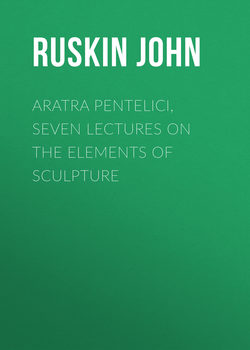Aratra Pentelici, Seven Lectures on the Elements of Sculpture

Реклама. ООО «ЛитРес», ИНН: 7719571260.
Оглавление
Ruskin John. Aratra Pentelici, Seven Lectures on the Elements of Sculpture
PREFACE
LECTURE I. OF THE DIVISION OF ARTS
LECTURE II. IDOLATRY
LECTURE III. IMAGINATION
LECTURE IV. LIKENESS
LECTURE V. STRUCTURE
LECTURE VI. THE SCHOOL OF ATHENS
LECTURE VII. THE RELATION BETWEEN MICHAEL ANGELO AND TINTORET.41
Отрывок из книги
1. If, as is commonly believed, the subject of study which it is my special function to bring before you had no relation to the great interests of mankind, I should have less courage in asking for your attention to-day, than when I first addressed you; though, even then, I did not do so without painful diffidence. For at this moment, even supposing that in other places it were possible for men to pursue their ordinary avocations undisturbed by indignation or pity,—here, at least, in the midst of the deliberative and religious influences of England, only one subject, I am well assured, can seriously occupy your thoughts—the necessity, namely, of determining how it has come to pass that, in these recent days, iniquity the most reckless and monstrous can be committed unanimously, by men more generous than ever yet in the world's history were deceived into deeds of cruelty; and that prolonged agony of body and spirit, such as we should shrink from inflicting willfully on a single criminal, has become the appointed and accepted portion of unnumbered multitudes of innocent persons, inhabiting the districts of the world which, of all others, as it seemed, were best instructed in the laws of civilization, and most richly invested with the honor, and indulged in the felicity, of peace.
Believe me, however, the subject of Art—instead of being foreign to these deep questions of social duty and peril,—is so vitally connected with them, that it would be impossible for me now to pursue the line of thought in which I began these lectures, because so ghastly an emphasis would be given to every sentence by the force of passing events. It is well, then, that in the plan I have laid down for your study, we shall now be led into the examination of technical details, or abstract conditions of sentiment; so that the hours you spend with me may be times of repose from heavier thoughts. But it chances strangely that, in this course of minutely detailed study, I have first to set before you the most essential piece of human workmanship, the plow, at the very moment when—(you may see the announcement in the journals either of yesterday or the day before)—the swords of your soldiers have been sent for to be sharpened, and not at all to be beaten into plowshares. I permit myself, therefore, to remind you of the watchword of all my earnest writings—"Soldiers of the Plowshare, instead of Soldiers of the Sword,"—and I know it my duty to assert to you that the work we enter upon to-day is no trivial one, but full of solemn hope; the hope, namely, that among you there may be found men wise enough to lead the national passions towards the arts of peace, instead of the arts of war.
.....
19. But, farther, let the ball have motion; then the form it generates will be that of a cylinder. You have, perhaps, thought that pure early English architecture depended for its charm on visibility of construction. It depends for its charm altogether on the abstract harmony of groups of cylinders,9 arbitrarily bent into moldings, and arbitrarily associated as shafts, having no real relation to construction whatsoever, and a theoretical relation so subtle that none of us had seen it till Professor Willis worked it out for us.
20. And now, proceeding to analysis of higher sculpture, you may have observed the importance I have attached to the porch of San Zenone, at Verona, by making it, among your standards, the first of the group which is to illustrate the system of sculpture and architecture founded on faith in a future life. That porch, fortunately represented in the photograph, from which Plate I. has been engraved, under a clear and pleasant light, furnishes you with examples of sculpture of every kind, from the flattest incised bas-relief to solid statues, both in marble and bronze. And the two points I have been pressing upon you are conclusively exhibited here, namely,—(1) that sculpture is essentially the production of a pleasant bossiness or roundness of surface; (2) that the pleasantness of that bossy condition to the eye is irrespective of imitation on one side, and of structure on the other.
.....